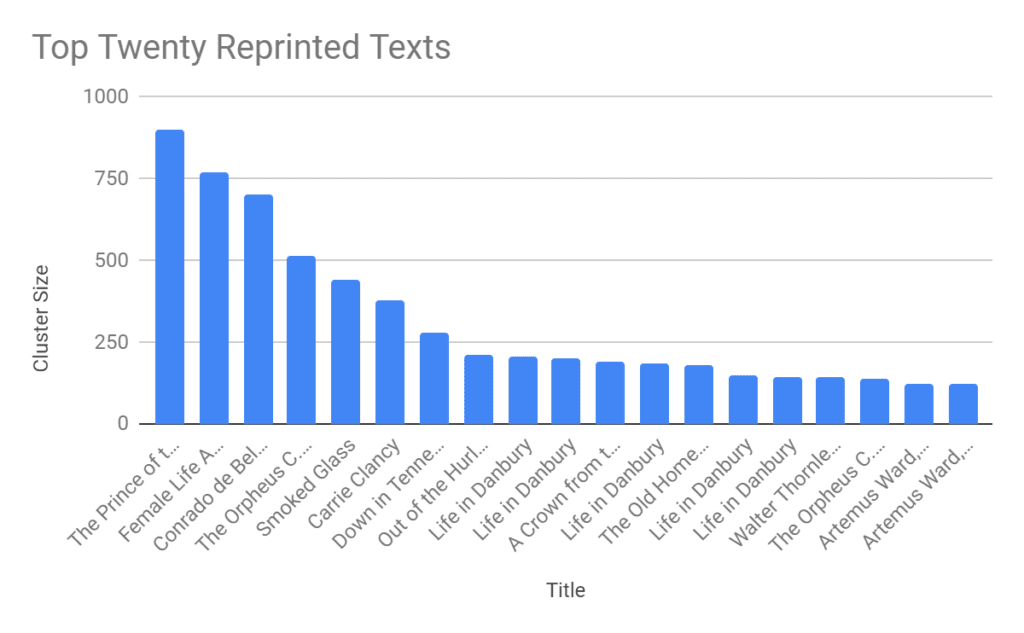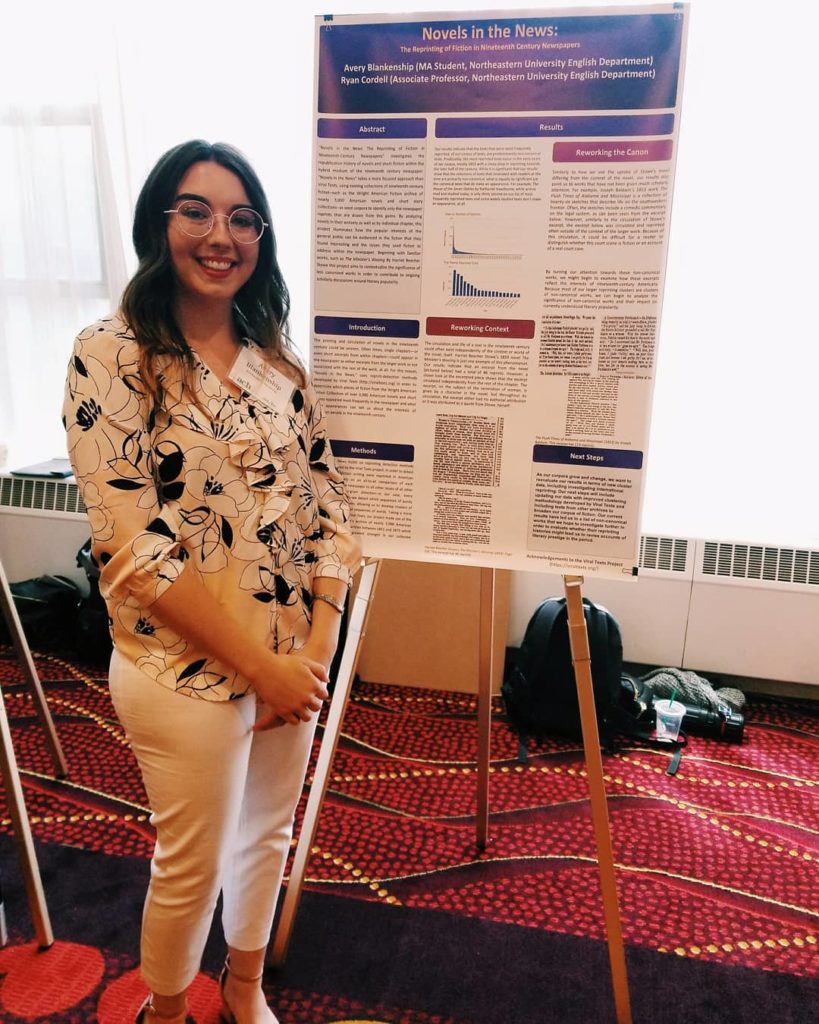The Association for Computers and the Humanities conference that was held in Pittsburgh last July was an incredible event. Having the opportunity to present the research that I have been working on through the Viral Texts project was really exciting professionally, and it gave me the opportunity to speak with other academics whose work I’ve admired for many years. In this post, I’m going to share a shortened version of the poster presentation that I gave alongside Professor Ryan Cordell. The title of our poster was “Novels in the News: the Reprinting of Fiction in Newspapers.”

Generally, our presentation focused on identifying the reprinting of works of fiction from the Wright American Fiction Collection of nearly 3,000 works of American fiction from roughly 1851–1875. This period is also the period of greatest strength in Viral Texts’ dataset of American newspapers. Using the reprint detection methods that have been developed by the larger Viral Texts project, we clustered occurrences of sets of 5 words in the newspapers that match the same 5-word clusters in the longer, fictional works. This way, we were able to roughly identify if an excerpt from the longer work was being reprinted in the newspaper, especially for more non-canonical works by anonymous authors. Our general goal was to try and identify common threads of readerly interest through tracking reprinting across the nation in the nineteenth century.

Initially, we sifted through our results focusing on canonical works like Uncle Tom’s Cabin by Harriet Beecher Stowe, which we already know had quite an impact on the periodical fiction scene of the nineteenth century. However, after reading through the results of more familiar works, we began to notice that some of the most heavily reprinted works of fiction are neither canonical nor reprinted in their entirety. Instead, short excerpts from longer works of fiction were circulating independently from the larger text, often without authorial attribution or context provided. For example, in the case of a lesser-known work by Harriet Beecher Stowe entitled The Minister’s Wooing, an excerpt from the novel on the topic of women’s veneration of men circulates independently from any indication that the excerpt is derived from a novel, and that the quoted bit of fiction is meant to be read as a satirical response to reader reviews. Instead, the excerpt circulates only occasionally with the title of the novel provided, and primarily with only “By Mrs. Stowe” appended. Because of this lack of context, the excerpt could easily be mistaken for Stowe’s own derisive comments on the status of women, rather than a satirical aside that she gives at the beginning of a chapter in a longer novel. In this situation, the power and popularity of Stowe as a public figure is invoked in using her name to circulate the excerpt.
Similarly, for a non-canonical work entitled Flush Times of Alabama and Mississippi by Joseph Baldwin, excerpts circulate in the newspaper with even less contextual information than what was provided in Stowe’s case. Flush Times is generally a collection of comedic sketches that are meant to criticize the legal system in the US, drawn from Baldwin’s own experiences working in legal offices. One example that we isolated is a comedic courtroom scene in which a man is facing charges for murder. The scene ends with the man admitting his guilt in order to “save the soul” of the person who is accusing him. In the longer sketch, it is clear that the man is actually guilty of the crimes he is being accused of, and so the ending is ironic. However, in the version that circulates in the newspaper, only the punchline of the scene is provided, which makes the excerpt read as though it were a faithful telling of an actual courtroom scene. To make matters even worse, often the character names are completely dropped and the titles of these excerpts are simply “A Courtroom Scene,” which does little to inform a potential reader of the origins of the excerpt.
Ultimately, our research has moved towards studying these occurrences of “fake news,” and unpacking what these excerpts from longer works of fiction can tell us about the interests of the nineteenth-century American public. Our next steps for this project involve including works of fiction from outside of the US as well, and rerunning our reprint detection algorithms to determine if international works shift our lists of most reprinted works and authors.
Avery Blankenship is second year Masters student in the English department. Her research interests include computational text analysis, nineteenth century American literature, and cookbooks. Currently, she is a member of the Viral Texts Project, the Early Caribbean Digital Archive, the Northeastern Writing Program Digital Archive, and the Boston Research Center. You can read more about the Viral Texts Project’s research at https://viraltexts.org/ as well as read draft chapters of the project’s forthcoming book project at https://manifold.umn.edu/projects/going-the-rounds.



